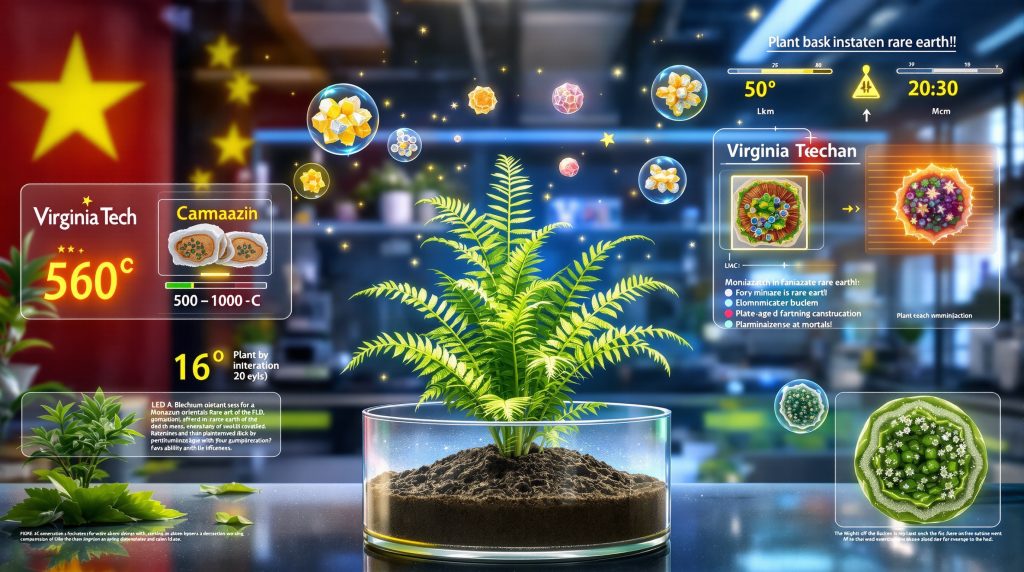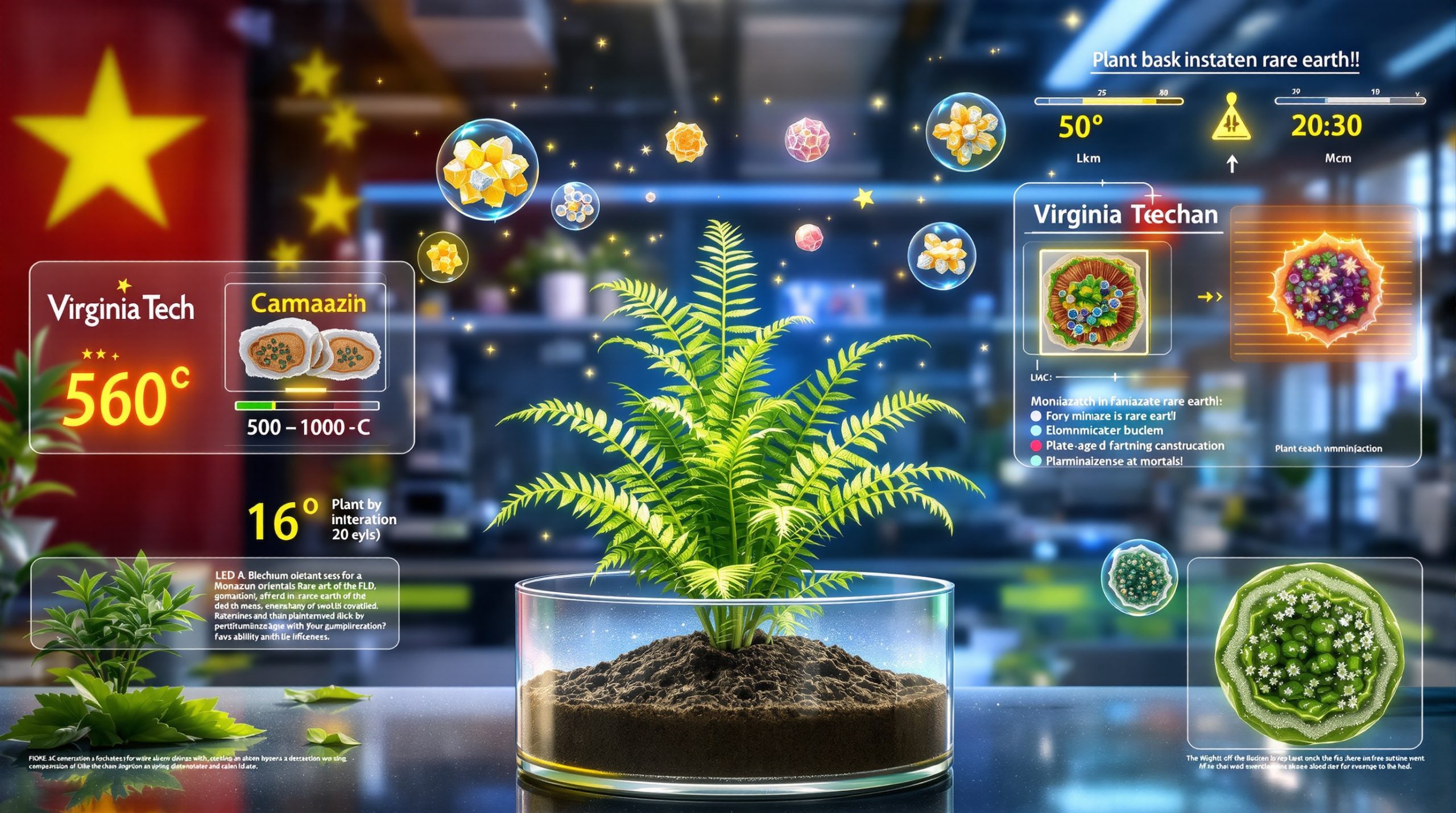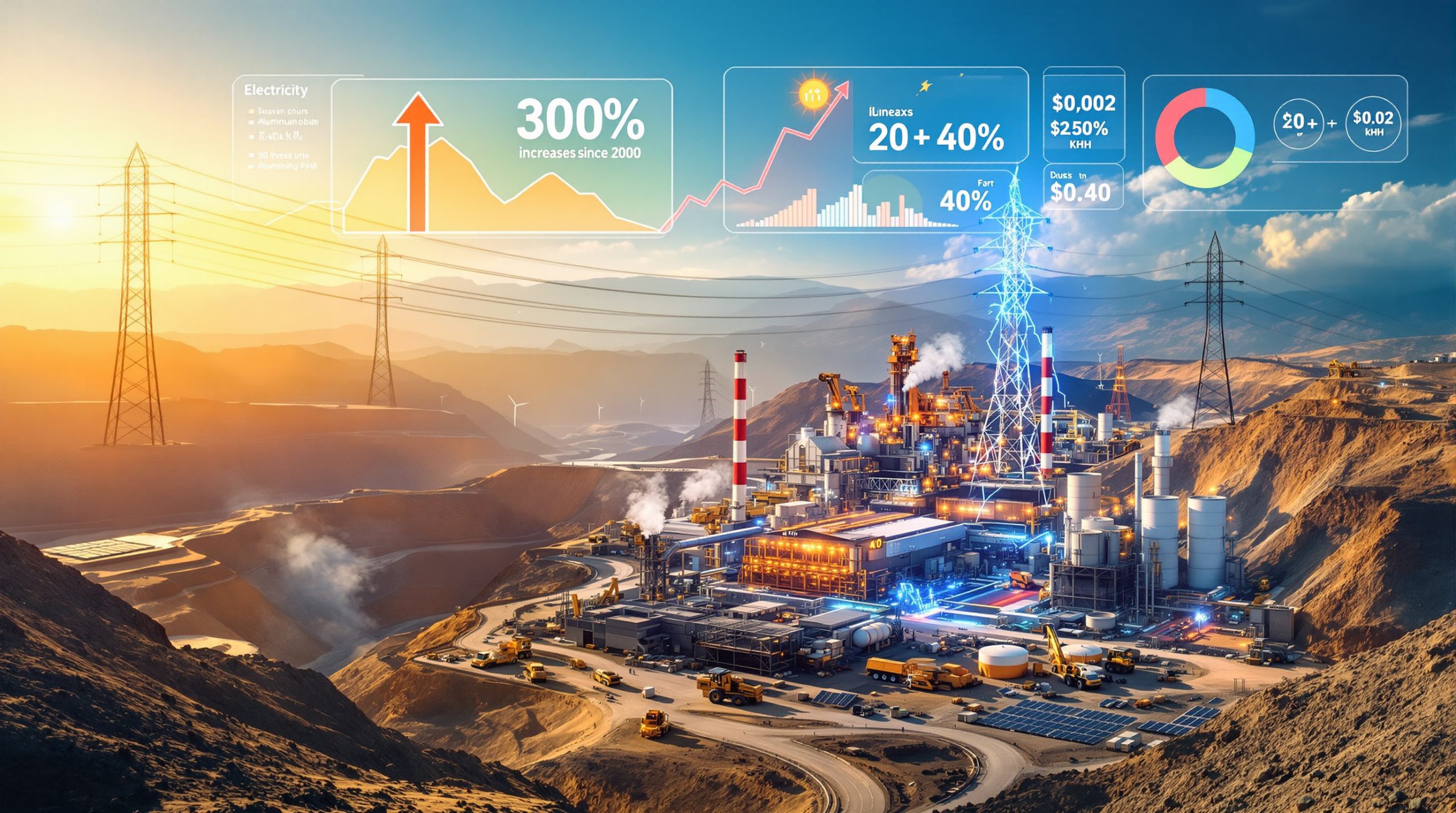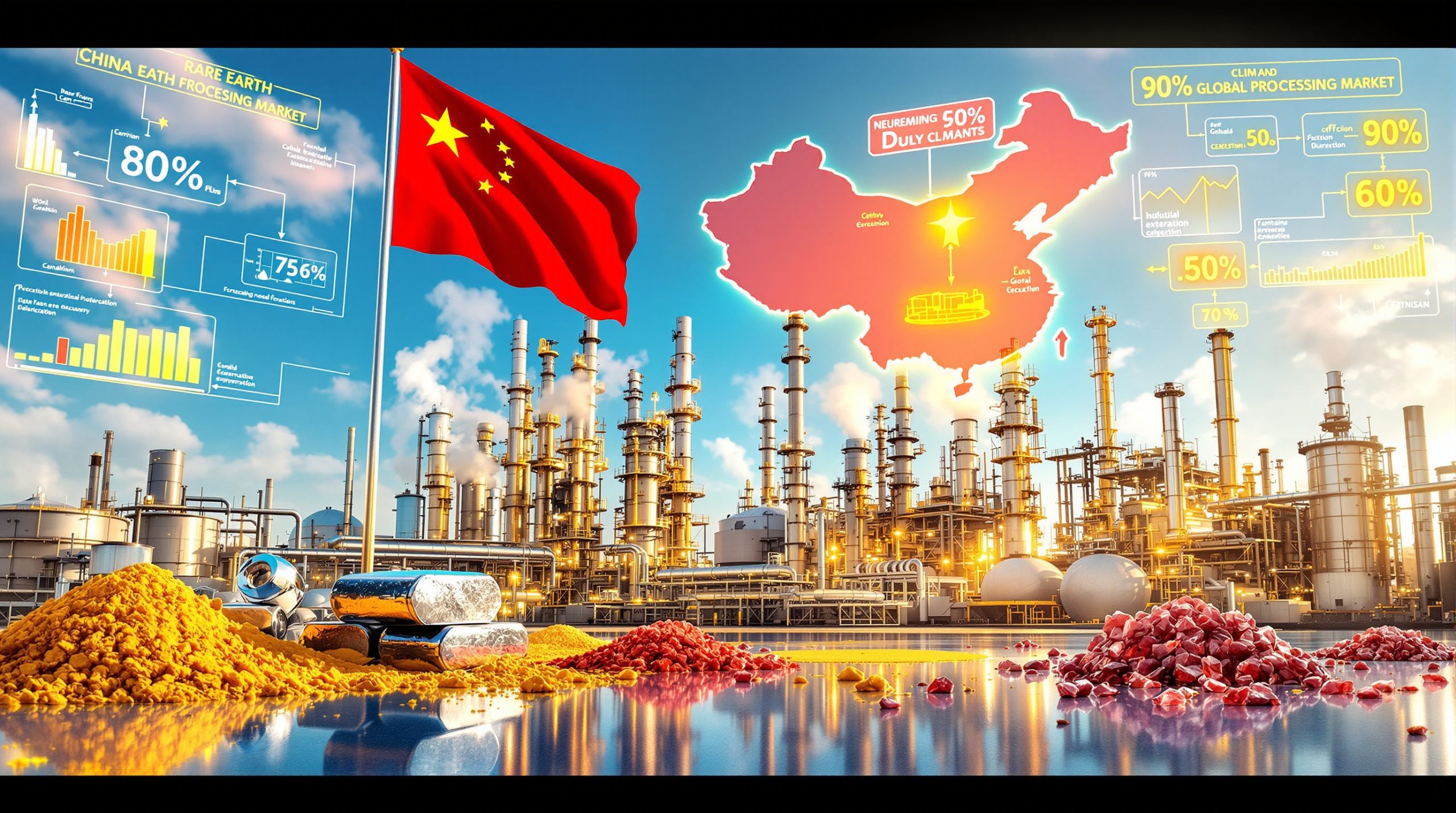Understanding the Revolutionary Biomineralization Breakthrough
China's fern-to-monazite discovery represents a significant advancement in biomineralization research, where scientists have documented the first instance of naturally crystallised rare earth minerals forming within living plant tissue. Research conducted by the Guangzhou Institute of Geochemistry at the Chinese Academy of Sciences, in collaboration with Virginia Tech, has revealed that the tropical fern Blechnum orientale produces nanoscale monazite crystals inside its cellular structures.
This breakthrough differs fundamentally from previous hyperaccumulator research, which typically focused on simple ion uptake rather than mineral crystallisation. The study, published in Environmental Science & Technology, demonstrates that rare earth elements don't merely accumulate as dissolved ions but undergo actual crystalline formation within the plant's vascular and tissue systems. Furthermore, this discovery could influence future waste management solutions across the industry.
The Science Behind Plant-Based Rare Earth Crystallisation
Biomineralization in hyperaccumulator plants involves complex cellular processes where absorbed rare earth ions combine with phosphate compounds to form stable crystal structures. Unlike geological monazite formation, which requires extreme temperatures exceeding 500°C and high-pressure environments deep within the Earth's crust, plant-based crystallisation occurs under ambient conditions.
The Blechnum orientale fern demonstrates remarkable efficiency in converting soil-based rare earth contamination into crystalline monazite through biological processes. This transformation occurs at standard atmospheric pressure and temperatures between 20-30°C, representing a dramatic departure from conventional mineral formation pathways. Additionally, this development could significantly impact the critical minerals transition currently underway globally.
Key Research Findings from the Guangzhou Institute Study
The collaborative research between Chinese and American institutions has produced several noteworthy discoveries about plant-based mineral formation. Scientists observed nanoscale monazite crystals distributed throughout specific plant tissues, particularly within vascular bundles and epidermal structures where rare earth concentration reaches optimal levels for crystallisation.
Laboratory analysis revealed that plant-derived monazite contains significantly reduced radioactive content compared to geological deposits. Traditional monazite often incorporates uranium and thorium during formation, creating radioactive challenges for industrial processing. The biological formation process appears to exclude these radioactive elements, potentially offering safer handling and processing advantages.
Critical Distinction: Plant-based monazite formation represents the first documented case of rare earth phosphate mineral crystallisation within living tissue, marking a significant advancement in both biomineralization science and potential extraction methodologies. Moreover, this breakthrough aligns with broader renewable energy mining initiatives.
How Does Plant-Based Monazite Formation Actually Work?
The hyperaccumulation process begins with root absorption of rare earth ions from contaminated soil environments. Blechnum orientale demonstrates exceptional capacity for extracting these elements from soil matrices, concentrating them within specialised cellular structures designed for detoxification and sequestration.
The Hyperaccumulator Process Explained
Hyperaccumulator plants employ sophisticated physiological mechanisms to manage potentially toxic metal concentrations. The fern's root system actively transports rare earth ions through vascular tissues, where cellular processes facilitate the combination of rare earth elements with phosphate ions derived from plant metabolism.
Ion precipitation occurs when rare earth concentrations reach saturation levels within specific cellular compartments. The crystallisation process serves as a protective mechanism, converting potentially harmful dissolved ions into stable, less bioavailable mineral forms that don't interfere with essential plant functions.
The step-by-step transformation process includes:
• Initial absorption: Root systems extract rare earth ions from soil solution
• Vascular transport: Specialised transport proteins move ions through plant tissues
• Cellular accumulation: Ions concentrate in specific tissue types and cellular compartments
• Phosphate binding: Rare earth ions combine with phosphate groups to form mineral precursors
• Crystal nucleation: Stable monazite crystals form through controlled precipitation processes
Comparing Traditional vs. Biological Rare Earth Extraction
The contrast between geological and biological monazite formation reveals significant differences in environmental requirements and resulting mineral characteristics:
| Formation Method | Temperature | Pressure | Radioactive Content | Formation Time | Environmental Impact |
|---|---|---|---|---|---|
| Geological Monazite | 500-1000°C | High (crustal) | High (U/Th present) | Millions of years | Extensive mining disruption |
| Plant-Based Monazite | 20-30°C | Atmospheric | Minimal/None detected | Weeks to months | Limited soil disturbance |
Biological formation eliminates the need for high-temperature, high-pressure conditions while potentially producing cleaner mineral products. However, the scale and speed of biological processes differ dramatically from industrial requirements, creating significant commercial challenges. This discovery contributes to ongoing mining decarbonisation trends worldwide.
What Are the Commercial Realities Behind the Green Mining Hype?
Despite the scientific breakthrough, substantial barriers exist between laboratory discovery and commercial viability. Current production capabilities demonstrate the vast gulf between experimental success and industrial-scale operations required for meaningful rare earth supply contributions.
Production Scale Limitations and Market Viability
Hyperaccumulator plants typically produce quantities measured in milligrams or grams per growing season, falling far short of the thousands of tonnes required for industrial rare earth applications. Even optimistic projections for scaled phytomining operations face fundamental biological and physical constraints that limit production capacity.
Land area requirements for meaningful rare earth production through phytomining would be enormous. Conservative estimates suggest that producing just one tonne of rare earth oxides annually would require hundreds of thousands of individual plants, demanding extensive agricultural infrastructure and management systems.
Growth cycle limitations further constrain production potential. Blechnum orientale requires specific environmental conditions and complete growing seasons to achieve maximum rare earth accumulation, making continuous production challenging compared to conventional mining operations that can operate year-round. Furthermore, this research highlights the importance of ESG mine planning in sustainable operations.
Processing Challenges That Remain Unsolved
The formation of monazite crystals within plant tissue represents only the initial step in rare earth processing. Critical downstream operations remain unchanged, including:
• Biomass processing: Converting plant material into extractable concentrate
• Solvent extraction: Separating individual rare earth elements from mixed concentrates
• Chemical purification: Achieving industrial-grade purity levels for specific applications
• Metalmaking: Reducing rare earth compounds to pure metallic elements
• Alloy production: Creating specialised materials for high-tech applications
China maintains dominant control over these downstream processing capabilities, processing thousands of tonnes annually through established industrial infrastructure. Plant-based extraction doesn't circumvent this processing bottleneck, meaning commercial success would still depend heavily on existing Chinese industrial capacity.
Economic analysis reveals that phytomining faces significant cost disadvantages compared to conventional extraction methods. Current rare earth prices reflect efficient large-scale mining operations, making small-scale biological production economically uncompetitive without substantial technological breakthroughs or policy interventions.
Is This Discovery a Genuine Environmental Solution?
The environmental implications of China's fern-to-monazite discovery extend beyond simple extraction alternatives, potentially offering solutions for contaminated site remediation and radioactive waste management in mining regions.
Phytoremediation Benefits for Contaminated Mining Sites
Southern China's rare earth mining regions face significant environmental challenges from decades of intensive extraction activities. Contaminated soils contain elevated levels of rare earth elements, heavy metals, and radioactive materials that pose long-term environmental and health risks.
Blechnum orientale and similar hyperaccumulator plants could provide dual-purpose solutions by simultaneously cleaning contaminated soils and recovering valuable materials. This approach addresses environmental liability while potentially generating economic returns from previously unusable land.
Radioactive waste management represents a particularly promising application. Plant-based stabilisation of thorium and other radioactive byproducts could reduce environmental mobility and long-term contamination risks associated with rare earth tailings and processing waste. According to recent research from the Chinese Academy of Sciences, this breakthrough marks a significant advancement in biomineralization science.
Pilot projects could demonstrate feasibility in specific contaminated areas, providing valuable data on remediation timelines, plant survival rates, and actual rare earth recovery quantities under field conditions.
Realistic Environmental Impact Assessment
Comprehensive environmental analysis reveals both opportunities and limitations for plant-based rare earth approaches. Carbon footprint comparisons suggest potential advantages for phytomining, as biological processes eliminate energy-intensive mining and initial processing steps.
Water usage requirements present mixed results. While phytomining avoids water-intensive mining operations, plant cultivation and biomass processing still require significant water resources, particularly in contaminated environments where irrigation may be necessary.
Waste stream analysis shows different but not necessarily superior environmental profiles:
• Plant matter disposal: Harvested biomass requires processing and disposal of organic residues
• Soil disruption: Repeated planting and harvesting cycles affect soil structure and ecosystems
• Chemical processing: Downstream purification still generates chemical waste streams
• Land use intensity: Large-scale operations require extensive agricultural infrastructure
Long-term sustainability depends on maintaining viable hyperaccumulator plant populations without depleting soil nutrients or creating ecological imbalances. Monoculture plantations could face disease pressure and genetic bottlenecks that compromise production stability.
What Does This Mean for Global Rare Earth Supply Chains?
The strategic implications of biological rare earth extraction extend far beyond technical capabilities, potentially reshaping geopolitical dynamics and industrial positioning within global supply chains.
Strategic Implications for China's Market Position
China's leadership in rare earth research reinforces its comprehensive control across all aspects of the industry, from fundamental scientific discovery through industrial-scale processing. The collaboration with Virginia Tech demonstrates China's ability to leverage international partnerships while maintaining technological leadership.
This discovery supports China's strategic narrative of environmental responsibility and technological innovation in critical materials sectors. By positioning itself at the forefront of green rare earth technologies, China addresses international criticism of its environmental practices while strengthening its long-term competitive advantages.
The research timeline and commercial development pathways remain under Chinese control, allowing strategic timing of technological releases and commercial applications to support broader economic and geopolitical objectives. As reported by Scientific research publications, this discovery represents the first documented case of successful rare earth phosphate crystallisation in living plant tissue.
Impact on International Rare Earth Strategies
International efforts to develop alternative rare earth supply chains face additional challenges from China's continued innovation in extraction methodologies. Even hypothetical green alternatives ultimately depend on Chinese processing infrastructure and technical expertise.
Potential opportunities exist for other nations with suitable climates and contaminated mining sites to develop parallel phytomining capabilities. However, success would still require access to downstream processing technologies dominated by Chinese companies.
Investment implications include:
• Technology development: Research funding for alternative hyperaccumulator species and processing methods
• Infrastructure adaptation: Modifying existing facilities to handle biological feedstocks
• Regulatory frameworks: Developing standards for plant-based mineral extraction and environmental remediation
• International cooperation: Creating partnerships that don't depend entirely on Chinese processing capacity
Should Investors Take This Discovery Seriously?
Investment analysis of China's fern-to-monazite discovery requires careful separation of scientific potential from near-term commercial reality, recognising both the technological breakthrough and fundamental scaling challenges.
Short-Term Market Reality Check
Current rare earth markets show no immediate disruption from biological extraction methods. Conventional mining operations continue expanding production capacity to meet growing demand from renewable energy and high-technology sectors.
Established rare earth companies maintain significant operational advantages through proven reserves, existing infrastructure, and established customer relationships. Plant-based alternatives don't threaten these advantages within investment-relevant timeframes.
Technology development timelines suggest commercial viability remains decades away, if achievable at all. Investors seeking near-term rare earth exposure should focus on conventional mining and processing companies rather than speculative biological alternatives.
Market pricing reflects efficient large-scale operations that biological methods cannot currently match. Without substantial cost reductions or regulatory advantages, phytomining faces fundamental economic disadvantages.
Long-Term Investment Considerations
Strategic investors may find opportunities in companies developing complementary technologies for sustainable mining and environmental remediation. These applications could prove commercially viable before full-scale rare earth extraction becomes economically competitive.
Research and development investments in hyperaccumulator plant breeding, biomass processing technologies, and integrated phytoremediation systems could generate returns through environmental services and niche applications.
Portfolio diversification through sustainable mining technologies offers exposure to potential regulatory changes favouring environmentally friendly extraction methods, even if biological approaches don't achieve full commercial scale.
Companies combining conventional rare earth operations with environmental remediation services using plant-based technologies could capture both current market opportunities and future regulatory advantages.
The Future of Sustainable Rare Earth Extraction
Technological integration between conventional and biological approaches may offer more realistic pathways than complete replacement of existing mining operations, combining the best aspects of both methodologies.
Emerging Technologies in Green Mining
Hybrid extraction systems could incorporate biological preprocessing to reduce environmental impact while maintaining industrial-scale throughput. Such approaches might use hyperaccumulator plants to concentrate rare earths from low-grade sources before conventional processing.
Advanced plant breeding and genetic optimisation could potentially increase accumulation rates and expand the range of suitable hyperaccumulator species. However, these developments require extensive research and regulatory approval processes that extend commercial timelines.
Integration with existing mining infrastructure offers more immediate applications than standalone biological operations. Phytoremediation of tailings areas could generate supplementary rare earth recovery while addressing environmental liabilities.
Global Research Initiatives and Collaboration Opportunities
International scientific partnerships beyond the current Chinese-American collaboration could accelerate development while distributing technological capabilities more broadly. European, Canadian, and Australian research institutions could contribute specialised expertise in plant biology and environmental science.
Technology transfer mechanisms could help developing nations with suitable climates establish phytomining capabilities for local environmental remediation while potentially contributing to global rare earth supply diversification.
Funding coordination between government agencies, private companies, and international organisations could support large-scale field trials necessary to validate commercial potential and environmental benefits.
Disclaimer: This article discusses emerging technologies and speculative market developments. Investment decisions should consider substantial uncertainties regarding commercial viability, regulatory approval, and market adoption timelines for biological rare earth extraction methods.
Ready to Capitalise on the Next Breakthrough in Mineral Discovery?
While biological rare earth extraction remains decades from commercial viability, the mining sector continues delivering immediate opportunities through conventional discoveries across Australia's resource-rich landscape. Discovery Alert's proprietary Discovery IQ model provides instant notifications of significant ASX mineral discoveries, transforming complex geological announcements into actionable investment insights for both short-term traders and long-term investors seeking exposure to Australia's next major breakthrough.




